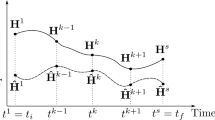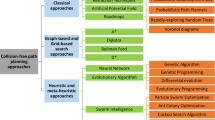Abstract
A new cascade load force control design for a parallel robot platform is proposed. A parameter search for a proposed cascade controller is difficult because there is no methodology to set the parameters and the search space is broad. A parameter search based on firefly algorithm (FA) is suggested to effectively search the parameters of the cascade controller. We used unified mathematical model of hydraulic actuator of parallel robot platform. These equations are readily applicable to various types of proportional valves, and they unify the cases of critical center, overlapped and underlapped valves. These unified model equations are useful for nonlinear controller design. The optimal results are compared to those obtained from other metaheuristic algorithms: GA, PSO and CS. A comparative study is also made between proposed optimal tuned cascade control using FA and well-tuned PID controller. Simulation results show the advantages of the proposed optimal tuned cascade controller using FA to solve a formulated tracking problem.












Similar content being viewed by others
References
Stewart, D.: platform with six degrees of freedom. Proceedings of the institution of mechanical engineers. J. Power Energy 180(15), 371–386 (1965)
Su, Y.X., Duan, B.Y., Zheng, C.H.: Nonlinear PID control of a six-DOF parallel manipulator. Control Theory Appl. IEE Proc. 151(1), 95–102 (2004)
Pi, Y., Wang, X.: Trajectory tracking control of a 6-DOF hydraulic parallel robot manipulator with uncertain load disturbances. Control Eng. Pract. 19(2), 185–193 (2011)
Stefanovic, M., Zhang, H.: Results on the robust observer-based position controller for parallel kinematic machines. J. Intell. Rob. Syst. 66(4), 417–428 (2012)
Merritt, H.E.: Hydraulic Control Systems. Wiley, New York (1967)
Filipovic, V., Nedic, N., Stojanovic, V.: Robust identification of pneumatic servo actuators in the real situations. Forschung im Ingenieurwesen Eng. Res. 75(4), 183–196 (2011)
Dihovicni, Dj, Nedic, N.: Simulation, animation and program support for a high performance pneumatic force actuator system. Math. Comput. Model. 48(5–6), 761–768 (2008)
Tao, G., Kokotovic, P.V.: Adaptive control of plants with unknown dead-zones. IEEE Trans. Autom. Control 39(1), 59–68 (1994)
Tao, G., Kokotovic, P.V.: Adaptive Control of Systems with Actuator and Sensor Nonlinearities. Wiley, New York (1996)
Soltanpour, M.R., Fateh, M.M.: Sliding mode robust control of robot manipulators in the task space by support of feedback linearization and backstepping control. World Appl. Sci. J. 6(1), 70–76 (2009)
Shafiei, S.E., Soltanpour, M.R.: Neural network slidingmodel-PID controller design for electrically driven robot manipulators. Int. J. Innov. Comput. Inf. Control 7(2), 3949–3960 (2011)
Spong, M.W., Hutchinson, S., Vidyasagar, M.: Robot Modeling and Control. Wiley, Hoboken (2006)
Heintze, J., Teerhuis, P.C., Van der Weiden, A.J.J.: Controlled hydraulics for a direct drive brick laying robot. Autom. Constr. 5(1), 23–29 (1996)
Sepehri, N., Dumont, G.A.M., Lawrence, P.D., Sassani, F.: Cascade control of hydraulically actuated manipulators. Robotica 8(3), 207–216 (1990)
Filipovic, V., Nedic, N.: PID regulators. Faculty of Mechanical Engineering, Kraljevo (2008)
Guo, H.B., Liu, Y.G., Liu, G.R., Li, H.R.: Cascade control of a hydraulically driven 6-DOF parallel robot manipulator based on a sliding mode. Control Eng. Pract. 16(9), 1055–1068 (2008)
Jelali, M., Kroll, A.: Hydraulic Servo-systems. Springer, Berlin (2002)
Rao, S.S.: Engineering Optimization: Theory and Practice. Wiley, New York (2009)
Niknam, T., Farsani, E.A.: A hybrid self-adaptive particle swarm optimization and modified shuffled frog leaping algorithm for distribution feeder reconfiguration. Eng. Appl. Artif. Intell. 23(8), 1340–1349 (2010)
Li, X., Yao, X.: Cooperatively coevolving particle swarms for large scale optimization. IEEE Trans. Evol. Comput. 16(2), 210–224 (2012)
Alfi, A.: Particle swarm optimization algorithm with dynamic inertia weight for online parameter identification applied to Lorenz chaotic system. Int. J. Innov. Comput. Inf. Control 8(2), 1191–1203 (2012)
Alfi, A.: PSO with adaptive mutation and inertia weight and its application in parameter estimation of dynamic systems. Acta Autom. Sinica 37(5), 541–549 (2011)
Alfi, A., Fateh, M.M.: Intelligent identification and control using improved fuzzy particle swarm optimization. Expert Syst. Appl. 38(10), 12312–12317 (2011)
Modares, H., Alfi, A., Fateh, M.M.: Parameter identification of chaotic dynamic systems through an improved particle swarm optimization. Expert Syst. Appl. 37(5), 3714–3720 (2010)
Alfi, A., Modares, H.: System identification and control using adaptive particle swarm optimization. Appl. Math. Model. 35(3), 1210–1221 (2011)
Shieh, C.S., Hung, R.T.: Hybrid control for synchronizing a chaotic system. Appl. Math. Model. 35(8), 3751–3758 (2011)
Mohideen, K.A., Saravanakumar, G., Valarmathi, K., Devaraj, D., Radhakrishnan, T.K.: Real-coded Genetic Algorithm for system identification and tuning of a modified model reference adaptive controller for a hybrid tank system. Appl. Math. Model. 37(6), 3829–3847 (2013)
Karanki, S.B., Mishra, M.K., Kumar, B.K.: Particle swarm optimization-based feedback controller for unified power-quality conditioner. IEEE Trans. Power Deliv. 25(4), 2814–2824 (2010)
Yang, X.S.: Nature-Inspired Metaheuristic Algorithms. Luniver Press, UK (2008)
Yang, X.S.: Firefly algorithms for multimodal optimization. Stochastic Algorithms: Foundations and Applications. Lecture Notes in Computer Science, Springer, Berlin 169-178 (2009)
Lukasik, S., Zak, S.: Firefly algorithm for continuous constrained optimization tasks. Computational Collective Intelligence. Semantic Web, Social Networks and Multiagent Systems. Lecture Notes Comput. Sci. 5796, 97–106 (2009)
Yang, X.S.: Firefly algorithm, stochastic test functions and design optimisation. Int. J. Bio-Inspired Comput. 2(2), 78–84 (2010)
Arora, S., Singh, S.: A conceptual comparison of firefly algorithm, bat algorithm and cuckoo search. International Conference on Control, Computing, Communication and Materials (ICCCCM), 3-4 August 2013, 1-4, Allahabad (India) (2013)
Yang, X.S.: Firefly algorithms for multimodal optimization. SAGA’09 Proceedings of 5th international conference on Stochastic algorithms: foundations and applications, Springer Berlin, 169–178 (2009)
Gandomi, A.H., Yang, X.S., Alavi, A.H.: Computers and Structures 89(23–24), 2325–2336 (2011)
Yang, X.S.: Nature-Inspired Optimization Algorithms. Elsevier, Amsterdam (2014)
Blackburn, J.F., Reethof, G., Shearer, J.L.: Fluid Power Control. The MIT Press Cambridge, Massachusetts (1960)
Paul, R.: Robot Manipulators: Mathematics, Programming and Control. MIT Press, Cambridge (1981)
Omran, A., Kassem, A.: Optimal task space control design of a Stewart manipulator for aircraft stall recovery. Aerosp. Sci. Technol. 15, 353–365 (2011)
Omran, A., Kassem, A., El-Bayoumi, G., Bayoumi, M.: Mission-based optimal control of Stewart manipulator. Aircr. Eng. Aerosp. Technol. J. 81(3), 147–153 (2009)
Huber, P.J.: Robust Statistics. Wiley, New York (1981)
Bernzen, W.: Zur Regelung elastischer Roboter mit hydraulischen Antrieben. VDI Fortschritt-Berichte Reihe 8 Nr. 788, VDI-Verlag, Düsseldorf (1999)
Cominos, P., Munro, N.: PID controllers: recent tuning methods and design to specification. IEEE Proc Control Theory Appl 149(1), 46–53 (2002)
Acknowledgments
The authors would like to express their gratitude to reviewers for their very useful comments and suggestions to improve this paper. This research has been supported by the Serbian Ministry of Education, Science and Technological Development through projects TR33026 and TR33027.
Author information
Authors and Affiliations
Corresponding author
Rights and permissions
About this article
Cite this article
Nedic, N., Stojanovic, V. & Djordjevic, V. Optimal control of hydraulically driven parallel robot platform based on firefly algorithm. Nonlinear Dyn 82, 1457–1473 (2015). https://doi.org/10.1007/s11071-015-2252-5
Received:
Accepted:
Published:
Issue Date:
DOI: https://doi.org/10.1007/s11071-015-2252-5




